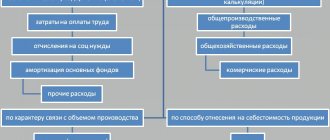Account 99 Profits and losses
Net profit (net loss) consists of the following components:
| Profit (loss) from sales | +- | Balance of other income and expenses | — | Income tax +- Payments for recalculation of income tax + Sanctions for violations of tax legislation | = | Net profit (loss) for the reporting period |
During the month, revenue and expenses for ordinary activities are recorded on account 90, other income and expenses on account 91.
When closing the month, the financial result is taken into account in account 99 Profit and loss. When making a profit in the reporting period, the following entry is made:
Debit 90-9 Credit 99 - profit from sales is reflected (the final turnover of the reporting month).
When a loss is incurred in the reporting period, the following entry is made:
Debit 99 Credit 90-9 - loss from sales is reflected (the final turnover of the reporting month).
When the amount of income exceeds the amount of expenses, the following entry is made:
Debit 91-9 Credit 99 - profit from other activities of the organization is reflected (the final turnover of the reporting month).
When the amount of expenses exceeds the amount of income, the following entry is made:
Debit 99 Credit 91-9 – reflects the loss from other activities of the organization (the final turnover of the reporting month).
Characteristics of account 99
Account 99 in accounting is an active-passive profit and loss account, i.e. it can have both a debit and a credit balance.
The contents of account 99 are described in detail in the current Chart of Accounts, approved by order of the Ministry of Finance of the Russian Federation dated December 31, 2000 No. 94n. In accordance with this document, information is accumulated on account 99:
- about the financial results that the enterprise receives from the main type of economic activity (in correspondence from account 90);
- on other income and expenses for the reporting period (in correspondence from account 91);
- on penalties imposed on payments to the budget and extra-budgetary funds, accrued payments and recalculations made for income tax (in correspondence from account 68).
For organizations in the agricultural sector, there is a Chart of Accounts, which was approved by the Ministry of Agriculture dated June 13, 2001 No. 654. According to this plan, when taking into account debit-credit turnover when calculating the financial result on account 99, it is also necessary to take into account income and losses from force majeure and other emergencies (fire, natural disasters, etc.). Income from an emergency includes insurance compensation received by the company and income from the sale of materials during the dismantling of destroyed buildings and structures. Costs in such situations include losses that are not compensated by the insurance company.
Analytical accounting for accounting 99 is structured in such a way as to ensure the generation of information for drawing up the final report on financial results.
Tax sanctions
If the tax inspectorate has assessed fines for violation of tax rules with income tax or similar taxes (UTII, Unified Agricultural Tax, single tax paid when applying the simplified tax system), which the organization does not intend to challenge, they are reflected in the accounting records as of the date of the decision to prosecute:
Debit 99 Credit 68 - a fine was assessed for violation of income tax rules.
Fines for violation of tax rules for other taxes, fines and penalties for insurance premiums, fines for late submission (failure to submit) of any declarations and reports to the Pension Fund are charged to other expenses and taken into account in account 91 on the date of the decision to prosecute.
The taxable profit of the amount of penalties, fines and other sanctions accrued for violations of tax legislation is not reduced (clause 2 of Article 270 of the Tax Code of the Russian Federation).
Transfer of account balance, posting Dt 99.09 - Kt 68.04.2
Many people quite often encounter the fact that when carrying out the standard 1C operation “Calculation of income tax”, the program automatically generates the posting “Transfer of account balance 68.04.02”.
With the introduction of new algorithms for calculations and postings in 1C, account 68.04.2 will now always be automatically closed in 1C. This will happen even if there are some errors in accounting or tax calculations.
Until 2014, account 68.04.2 could automatically have a balance reflecting accounting errors. We could also reflect some unrounded kopecks in this account. Let us remind you that since 2014, the legislation requires that all accrued taxes be rounded to the nearest whole ruble. Thus, there should no longer be any kopecks in this account.
If you still have some kind of somersault on account 68.04.2, then this indicates possible accounting errors. In this case, it is necessary to conduct a thorough analysis of the data. But we need to analyze not the balances of this account, but the turnovers for 68.04.2 and 99.09.
The income tax audit report will help you check the correctness of your accounting and balances. When viewing the data, also pay attention to whether you have the following formula: BU=NU+PR+VR, where BU and NU are accounting and tax, respectively, PR are permanent accounting differences, VR are temporary accounting differences.
If you have a fairly large amount, then you need to carefully study the data in 1C in tax accounting for profits.
If there are errors in the report, then this section is highlighted with a red frame, which signals the accountant about the errors.
It is also important to check the amount of profit in the tax return with the amount of profit indicated in the financial results report.
You can also additionally check using the 1C document “Regulatory Operation” by setting the type of operation to calculate taxes on profits. As a result of a standard regulatory operation, standard transactions will be automatically created.
A standard tax transaction document is created as follows:
- Select the “Operations” item in the menu, then select “Period Closing” and the “Routine Operations” item;
- You also need to select the appropriate type of operation and click the “Create” button;
- Then, to view the data, you need to select showing transactions and other document movements.
Study carefully all the data received.
If you are interested in decoding the amounts of temporary differences written off, you can view it in the “Help” report by selecting the item for calculating tax liabilities/assets. It can be found in the “Operations” menu, the “Period Closing” item in “Inquiries”, then clicking on “Calculations”.
After viewing the generated reports, you will quickly and easily find inconsistencies in the data and be able to correct them.
Closing account 99 at the end of the year
At the end of the year, the balance sheet is reformed - all subaccounts to accounts 90, 91 and 99 are closed with internal entries. After this, the balance remains only on subaccount 99.01. This is the financial result of the reporting year; it is written off to account 84.
Reformation of the balance sheet is the final operation of the reporting year. As of January 1 of the following year, the balance in account 99 should be zero.
If at the end of the reporting year a profit is made (the account balance is 99 credits), the following entry is made:
Debit 99 Credit 84 - reflects the net profit of the reporting year.
If at the end of the reporting year a loss is received (account balance 99 is debit), the following entry is made:
Debit 84 Credit 99 - reflects the net (uncovered) loss of the reporting year.
Closing account 99 at the end of the month - postings
Every month, based on the results of its work, the company calculates the total financial result. The amount of profit or loss is accrued according to the account. 90 and 91. Subtotals are credited to the account. 99. Let's give typical wiring using a specific example.
Let’s assume that a wholesale company sold electrical goods worth RUB 826,000 in October, including VAT 18% RUB 126,000. The cost of sold devices is 550,000 rubles. The procedure for reflecting data in accounting:
- D 62 K 90.1 for 826,000 rubles. – sales of electrical goods were carried out.
- D 90.3 K 68.2 for 126,000 rubles. – VAT is added to the sales price.
- D 90.2 K 41.1 for 550,000 rubles. – the purchase amount of sold devices was written off.
- D 90.9 K 99 for 150,000 rubles. – profit for November has been generated. If the transaction resulted in a loss, a reverse entry will be made.
Consequently, it is not the analytical subaccounts opened for the “Revenue” account that are subject to closure on a monthly basis, but only synthetic data. Account 99 monthly reformation is not subject to. Additionally (when the company carries out other operations), the account is reset to zero. 91 according to the algorithm valid for the account. 90:
- D 91.9 K 99 – profit from other business operations of the company is calculated.
- D 99 K 91.9 – loss closed.
Instructions 99 count
Instructions for using the chart of accounts for accounting the financial and economic activities of organizations in accordance with Order No. 94n dated October 31, 2000:
Account 99 “Profits and losses” is intended to summarize information on the formation of the final financial result of the organization’s activities in the reporting year. The final financial result (net profit or net loss) is made up of the financial result from ordinary activities, as well as other income and expenses.
The debit of account 99 “Profits and Losses” reflects losses (losses, expenses), and the credit shows the profits (income) of the organization. A comparison of debit and credit turnover for the reporting period shows the final financial result of the reporting period.
Account 99 “Profits and losses” during the reporting year reflects:
- profit or loss from ordinary activities - in correspondence with account 90 “Sales”;
- balance of other income and expenses for the reporting month - in correspondence with account 91 “Other income and expenses”;
- the amount of accrued conditional income tax expense, permanent liabilities and payments for recalculation of this tax from actual profit,
- as well as the amount of tax penalties due - in correspondence with account 68 “Calculations for taxes and fees”.
At the end of the reporting year, when preparing annual financial statements, account 99 “Profits and losses” is closed. In this case, by the final entry of December, the amount of net profit (loss) of the reporting year is written off from account 99 “Profits and losses” to the credit (debit) of account 84 “Retained earnings (uncovered loss)”.
The construction of analytical accounting for account 99 “Profits and losses” should ensure the generation of data necessary for drawing up a profit and loss statement.
Account 99 in accounting
The name of the account clearly indicates its purpose: the account is used to accumulate and reflect the final financial result. Profits and income are reflected on the credit of the account, losses and expenses are reflected on the debit.
In general, the structure of account 99 can be represented by the following diagram:
Throughout the year the account reflects:
- profits (losses) from ordinary activities - in correspondence with account 90;
- profits (losses) from other activities - in correspondence with 91 accounts;
- the amount of accrued conditional income (expense) for income tax;
- amounts of permanent obligations and accrued payments, penalties, penalties, etc.
The account movements can be shown schematically as follows:
Extraordinary income (expenses) are the receipts (expenses) of funds associated with unplanned events. For example, receipts of insurance compensation, losses due to natural disasters and emergency incidents, etc.
At the end of the reporting year, account 99 is closed to account 84 “Retained earnings (loss)”, and there is no balance left on it. Profit will be reflected by posting Dt 99 - Kt 84, loss Dt 84 - Kt 99.
Account 99 corresponds with the accounts:
Posting Dt 99 - Kt 09 means the disposal of the ONA object accounted for Dt 09.
Subaccounts 99 accounts
Analytics of account 99 should be built taking into account the possibility of generating a Report on the financial results of the enterprise. For these purposes, it is recommended to create main subaccounts for the account:
- 99.1 - profits and losses (except for NP);
- 99.2 - income tax;
- 99.3 - extraordinary income (expenses);
- 99.6 - tax sanctions;
- 99.9 - other losses and profits.
At the discretion of the organization, the numbers and purpose of subaccounts may change. Also, to reflect information in more detail, organizations can create 3rd or 4th level subaccounts for these subaccounts.
According to the current Chart of Accounts, income tax (IP) is charged to account 99 in correspondence with account 68, a subaccount for settlements under IP. For this purpose, separate sub-accounts are created on account 99, most often 99.2 “Income Tax”, which can be divided into sub-accounts to reflect conditional income and conditional expenses for NP.
The amount of tax accrued to the budget is reflected by posting Dt 99 - Kt 68.
Posting of the type Dt 68 - Kt 99 “Conditional income under NP” reflects the loss received in accounting.
Closing 99 accounts
There are several ways to close a 99 account. But the method using subaccount 99.9 can be considered methodologically correct. In this case, the total for all subaccounts 99 is collected in this account, that is, the subaccount can be called regulating.
During the year, when the account is closed monthly, the balance Dt means a loss, the balance Kt means profit. Consequently, when closing the year in correspondence with account 84, the debit balance will mean a profit, and the credit balance will mean a loss.
Typical transactions for account 99
By debit of the account
| Contents of a business transaction | Debit | Credit |
| The amount of tax accrued for the reporting period | 99 | 68 |
| A fine was assessed for violating the rules of taxation with income tax (UTII, Unified Agricultural Tax, tax paid when applying the simplified tax system) | 99 | 68 |
| The net profit of the reporting year is reflected during the balance sheet reformation | 99 | 84 |
| Reflected loss from ordinary activities | 99 | 90-9 |
| Reflected loss from other activities | 99 | 91-9 |
How is the structure formed?
In accounting, account 99 is classified as active-passive, since by credit you can see generalized information about the profit received, and by debit - all losses resulting from recorded expenses.
Profits and losses are generated through:
- 90 “Sales” - used by companies to reflect income and expenses from sales for their core activities;
- 91 “Other income and expenses” - it accumulates income and expenses from other activities;
- conditional income/expense from the application of tax is calculated;
- penalties are reflected.
Constant and deferred tax liabilities and assets take an active part in the formation of the results.
Important point! The count 99 is synthetic. Analytical accounting should be carried out without fine detail, grouping the information necessary to generate a statement of financial results.
Sub-accounts where information is collected:
- 99.01 “Profits and losses from business activities.”
- 99.02 “Income tax”.
- 99.07 “Other profits and losses.”
- 99.09 “Net profit/loss”.
In turn, sub-accounts are divided into smaller groups. Thus, 99.02 is formed as a result of movements:
- 99.02.01 “Conditional income tax expense”;
- 99.02.02 “Conditional income for income tax”;
- 99.02.03 “Permanent tax liability (asset)”;
- 99.02.04 “Recalculation of deferred tax assets and liabilities.”









